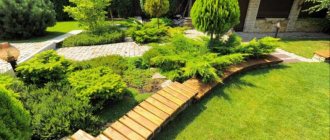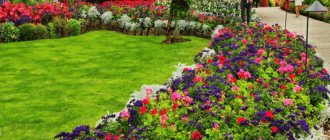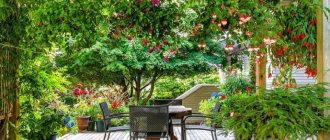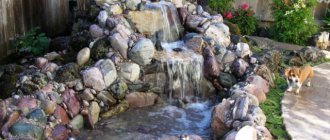Home Landscape design
Having built a rock garden on your garden plot, the time has come to breathe life into it - that is, to combine the dead with the living, to create a harmonious composition of stones and plants. Many people prefer to plant flowers on an alpine hill that do not need to be renewed annually, namely perennials. Having planted such plants for the rock garden once, they will decorate your rocky garden for many years. Most representatives of this group are meadow flowers that do not correspond to the style of rocky gardens, but there are also mountain meadow species suitable for rock gardens that play the role of seasonal dominants. Many have beautiful foliage, which is very important, because a rockery should be beautiful not only during flowering. Unfortunately, such perennials for alpine hills “denude” the garden during cold weather, so plant crops whose above-ground parts die off for the winter after the woody ones.
- 2 Types of perennials for alpine slides: photos and names
- 3 What ephemeral flowers can be planted on an alpine hill
- 4 The best perennial flowers for rockeries: photos and names of plants
- 5 Which mountain flowers are suitable for an alpine slide?
- 6 Perennial flowers for rock gardens: photos and names
Functions of plants for a rocky garden and alpine slide
So, for example, shade-loving species are not suitable for a sunny rocky hill, etc. But when selecting plants for rocky gardens (rockeries), one more important factor must be taken into account - their naturalness, “naturalness”. On a rocky hill, lush garden flowers are inappropriate, as they distract attention from the overall composition. In addition, all plants should be compact and, if possible, look neat and beautiful all year round. Therefore, give preference to natural species and varieties similar to them, especially plants with wintering leaves and shoots that decorate the garden even in winter.
The main functions of plants for a rock garden are as follows:
- emphasize the beautiful elements of the rock garden;
- hide unsuccessful elements of the composition, ugly or unnaturally laid stones (conifers and ground cover perennials are suitable for this);
- soften and enliven the composition;
- delight the eye with a variety of colors and textures of leaves, beautiful flowering.
Plant plants in the order in which they are discussed in this article - this will help you correctly create a composition and provide the plants with the best living conditions.
Mixborders in landscape design: photos of design options
Mixborders are flower beds in free combination, which are very popular in landscape design. If creating an alpine slide requires considerable effort, then a mixborder will be tough for even novice gardeners. Using the recommendations of plant selection experts and photo diagrams of mixborders, you can easily decorate paths with flowering hedges or outline areas of your site with your own hands.
Thus, the choice of location for this universal flower garden will depend on its purpose. Mixborders are used as:
- curb along the paths on the site;
- hedge to separate functional areas;
- for decorating unsightly areas of the territory;
- internal or external border of the site.
Mixborder of perennials on a summer cottage
These criteria are taken into account when selecting plants for mixborders. After all, it can use both tall and low-growing plants, even ground cover. Mixborders made from conifers and shrubs look great. Schemes of various options can be combined to suit your taste. For example, a mixborder made from spherical thuja and petunia looks very impressive. The uniform greenery of conifers creates a wonderful background for bright and elegant flowers.
Another option could be a mixborder made only from tall-growing plants. A lush green fern is planted as a background, and in front of it is any kind of tall flowers with a bright color, for example, astilbe.
Flowerbed of low-growing shrubs and flowers
The three-stage mixborder consists of even, neat rows of flowers of different heights. These can even be plants of the same species, but with a variety of colors. To create such a flower garden, you need to know what level of growth the flowers reach. Their flowering period must also coincide.
You can also frame the mixborder with rounded, identical-sized stones of soft colors. Their monochromaticity will create the desired contrast and emphasize the play of colors in the flower garden.
Mixborder can be supplemented with small stones
A mixborder made from such green plants as fern, dracaena, zelenchuk, kupena, and red-leaved agloanema looks exotic. This composition lacks the variety of colors of flowering plants. But its beauty lies in the contrasts between different shades of green and interspersed with white and red elements.
If you want to emphasize the brightness or unusual color of one particular plant, then it is better to limit yourself to one row of the flower bed. An excellent example would be a row of imperial hazel grouse (the photo of the flowers conveys all the splendor of such a mixborder).
Flower garden of white and pink petunias
It would be better to plant low-growing plants in several rows so that they do not look poor and create the composition of a continuous hedge. An example would be ground cover plants or mixborders made from ornamental cabbage.
Plants for mixborders, their planting scheme
If you do not plan to change the design style of your mixborder every year, then you should populate it with perennial plants. They are not demanding to care for, and the variety of their species and varieties will satisfy even the most demanding gardener. They will tell you how to create mixborders from perennials, photo diagrams indicating the planting location of a particular plant.
Mixborder diagram: 1 - tree hydrangea; 2 - shrubby cinquefoil; 3 - Japanese spirea; 4 — soft cuff; 5 — juniper Sky rocket; 6 — Blaubux aster; 7 - alpine aster; 8 - Armenian speedwell; 9 - carnation grass; 10 - delphinium; 11 - giant onion
If you want to change the appearance of your flower beds beyond recognition every year, include bulbs and annuals in your composition. With the help of ground cover plants, a general background is created, and ornamental grasses and deciduous shrubs will bring natural harmony to the overall composition.
When choosing plants, be sure to take into account their flowering periods so that the flower garden does not look unkempt and inorganic. A competent selection of crops will provide the mixborder with continuous flowering and an elegant appearance. Some photos of mixborders with intensely flowering species are attractive with a variety of colors. But here you need to know when to stop and not overload the flower garden with a large number of colors.
Scheme for creating a mixborder from coniferous shrubs
Arrangement of a classic mixborder in stages
It is no secret that the final result depends on the personal preferences and inspiration of the creator of the flower garden. But there are the main stages of creating a classic mixborder, which you need to become familiar with to achieve the most picturesque look:
- Planting basic (skeletal) slow-growing plants (shrubs or conifers). These can be juniper, dwarf species of thuja, pine, elderberry, jasmine, white turf.
- Filling the flower bed with perennial plants. How to create a mixborder from perennials, patterns and names of flowers can be studied step by step on the websites of gardeners or landscape designers. These are mainly plants of medium height, the purpose of which is to decorate the stems of shrubs growing behind.
- Complementing the picture with annual and bulbous plants. They are planted in empty spaces in front of perennials. Be sure to include primroses, which will fill the mixborders with the first sunny days with a spring mood.
Arranging a flower garden with your own hands
Whatever your idea for the landscape design of the site, remember that it is quite possible to create a beautiful flower garden or hill on your own. Arm yourself with the necessary tools, study photos and diagrams of mixborders or alpine slides, select the plants you like and feel free to get to work. You will see that soon your site will be able to boast of a well-groomed, unique landscape design created by yourself.
Types of perennials for alpine slides: photos and names
Perennial plants for alpine hills with foliage that dies off during the winter can be divided into the following types:
- Species that form narrow-leaved bunches are corollas, anticleas, paradiseas, liatris, daylilies, and many irises. They look organic in any composition, especially next to large stones. Low-growing forms of perennials for rock gardens, such as sisirhynchium and dwarf ornamental grasses, are good for group planting.
- Species that form large but compact bunches of leaves or shoots - ferns, hostas, astilbes, thorns, ash trees, rhodiola. Such flowers for rockeries look best near stones, at joints and at the foot of terraces.
- Species that form low-growing curtains are spectacular, but often capricious plants: primroses, edelweiss, lumbago, cranberry, gentian, armeria, rock bells, miniature ferns. Plant perennial flowers for alpine hills in isolated holes and in small groups on small terraces.
- Species growing in tall clumps. Most are shade-tolerant forest plants . Some can be quite aggressive, such as lilies of the valley, kupenas, disporums, bergenias; use them in large flat-type rock gardens or to secure slopes. Other flowers for rock gardens grow compactly: mountain weeds, jeffersonias, uvularia, “curtain” ferns; the best place for them is spacious terraces.
- “Giants” are plants too large for rockeries. Only in large gardens can you use a few slender species with beautiful leaves: Volzhanka, black cohosh, buzulniki, Rogersia, ascylboides, peltiphyllum. Plant these perennials for rock gardens individually or in small groups - this is the only way they will demonstrate all their beauty.
There are a huge number of leaf-shedding perennials suitable for rocky gardens, so we will focus only on the species typical of the most common type of rockery - the alpine slide.
To successfully grow the plants presented below, it is necessary to follow not only the rules specific to each species, but also the rules of agricultural technology common to all of them:
- Replant in early spring (before active growth begins) or in the second half of summer (after growth ends).
- Plant perennials on light, humus-rich loams with an acidity of 5.5 - 6.
- In autumn, cut off all plants that have not retained or formed green shoots at ground level.
- For successful wintering, carry out hilling or mulching in the fall, cover capricious species with a layer of leaves to a height of 10-20 cm.
Next you can see the photos and names of the best perennial flowers for alpine slides.
What ephemeral flowers can be planted on an alpine hill
Ephemeroids are plants that have a very short growing season. They bloom in spring or early summer, after which they shed their leaves. They are planted in rockeries last and only in the fall.
What ephemeral flowers can be planted on an alpine hill?
Snowdrops, white flower beds, corydalis, crocuses, iridodictiums, kandyks, chionodoxes, scyllas, pushkinias, muscari, and, of course, tulips, daffodils and hyacinths are perfect for these purposes. They bloom for a short time, but are catchy and impressive, for which they are loved by gardeners.
These plants for rockeries have a single, but serious drawback - after flowering they look inconspicuous, and during the period of foliage dying off they do not decorate the rock garden, but rather spoil it. However, there is no need to abandon ephemeroids - you just need to choose the right types.
The best perennial flowers for rockeries: photos and names of plants
When choosing flowers that are ideal for an alpine slide, pay attention to the following plants.
Anticlea elegans (Zygadenus )
Anticlea gracilis (Zigadenus) in the photo
The flowers of Anticlea graceful
Bulb have no summer dormancy. The plant is suitable for all large rockeries. Looks great near the stones, next to the “swamp”, in a mixborder.
Bulbous plant. This perennial flower, suitable for an alpine hill, did not get its name by chance - it is, indeed, very elegant. Narrow bluish basal leaves are collected in bunches up to 40 cm high. It blooms in early summer. The flowers are small, yellow-green, collected in a narrow paniculate inflorescence, the peduncle is about 70 cm tall. Prefers rich soils. It grows well both in partial shade and in open areas. It is moisture-loving, but can withstand temporary drying out. Winter-hardy without shelter.
All representatives of the genus are suitable for rockeries.
Armeria – Armeria
The most compact:
Armeria soddy in the photo
(A. caespitosa) in the photo
Armeria seaside in the photo
(A. maritima) in the photo
Armeria maritima (A. maritima), forming cushions of narrow, partially overwintering leaves.
As you can see in the photo, the inflorescences of these plants for alpine slides are capitate, the flowers are often pink, the peduncles are from 3 to 30 cm high:
Armeria are very effective in small and narrow holes, in crevices of retaining walls and rocks, between slabs of paths.
They prefer open sunny places, poor and well-drained soils. Drought resistant. Winter-hardy without shelter, they freeze only in very cold, snowless winters.
Venechnik
Anthericum
All species are showy, elegant plants. Narrow basal leaves are collected in rosettes. They bloom in early summer with snow-white flowers collected in lush paniculate inflorescences.
Peduncles height from 60 to 150 cm. Excellent as seasonal dominants.
Pay attention to the photo how well these rockery plants complement large compositional groups:
They are undemanding to soil, but develop better on nutritious loams. Prefers a sunny location, but tolerates shade. Shelter for the winter is not required.
Catchment in the photo
Aquilegia in the photo
For rocky gardens, the fan-shaped catchment (A. flabellata) is most suitable - a dwarf species no more than 15 cm high (varietal forms can reach 30 cm).
This perennial alpine plant got its name from the ability of its leaves and flowers to collect and store rainwater and dew. The leaves near the catchment area are bluish-green and pinnate. The flowers are large, with short spurs, blue, white or pink; bloom in early summer. It is undemanding to soils, but lives longer in loose soils than in heavy or peaty ones. Prefers a sunny or semi-shady location. Easily tolerates transplantation. Drought resistant. Winter-hardy. Blooms profusely, but does not last long.
Bell in the photo
Campanula in the photo
What mountain flowers are suitable for an alpine slide?
Mountain plants are those flowers that are ideal for alpine slides. Growing rock species of bells and saxifrages, gesneriaceae, gentians, lewisias, dwarf ferns and other “highlights” of rocky gardens requires considerable experience and patience. “Rarities” are planted in small holes and in crevices between stones, while trying to distinguish them from the overall composition. Sometimes you have to prepare a special soil substrate, specially drain the planting site, or install a canopy to protect it from rain. Many of these plants need a certain acidity of the soil that differs from the general background and the presence of a certain type of stone in the neighborhood.
Most mountain plants and flowers, when grown on an alpine hill, do not tolerate close groundwater and stagnation of water on the soil. They grow well on small shaded terraces of rocky hills.
However, if you grow a rare saxifrage, gentian, chickweed or breaker, you will have a legitimate reason for pride.
Below you will see photos and names of mountain flowers suitable for rock gardens.
Gentian in the photo
Gentiana in the photo
Relatively unpretentious species:
Gentian seven-parted in the photo
(G. septemfida) in the photo
Rough gentian in the photo
(G. scabra) in the photo
Chinese gentian decorated in photo
(G. sinoornata) in the photo
They bloom in late summer - autumn, and live for many years without replanting or special care.
The situation is more complicated with dwarf alpine gentians that bloom in early spring:
Stemless gentian in the photo
(G. acaulis) in the photo
Gentian Delecluze in the photo
(G. clusii) in the photo
Spring gentian in the photo
(G. verna) in the photo
Plant them in well-drained holes protected from the wind, filled with loose fertile soil and fine limestone crushed stone. Replant only in early spring, water in summer and protect from the scorching sun. And remember: all the difficulties of care will be paid off with the joy of long and lush flowering.
Levisia cotyledon in the photo
Lewisia cotyledon in the photo
A beauty that would be most suited to a cold greenhouse, but it can also bloom in open ground, in a crevice or hole protected from rain.
As you can see in the photo, even the rosettes of these flowers are original for the alpine hill - evergreen, similar to large juveniles:
In May, flower stalks appear from the rosettes, on which flowers 3 cm in diameter bloom. The main condition for the successful development of a plant is the correct choice of planting site. The soil should be permeable, nutritious, and the rosette should remain dry if possible.
Haberleia rhodopianum in the photo
Haberlea rodopensis in the photo
Visual planting schemes
At first glance, it seems that creating an organic composition on your own is a difficult, almost impossible task. Firstly, this is not true, and if you have a working diagram at hand, there will not be any special problems. Secondly, you can always take advice from landscape design specialists. In the end, on our website there is always a sensible photograph and a detailed description of the landing schemes.
On each of the tiers you will have specific types of plants growing:
- Foot. It is best to plant species that prefer fertilized, moist soil. The list of “must have” plants includes turf pike and some other ornamental grasses, juveniles and saxifrage.
- Middle tier. Designed for less demanding representatives of mountain flora. The lighting here is a little poorer, so phlox and primroses will come in handy. To avoid the occurrence of voids, additional ground cover sedums are planted between the flowers.
- At the very top we recommend placing early flowering annuals and perennials, as well as bulbous ones. This is explained by the fact that they love dry soil and cannot develop normally without sunlight. Iberis will help make the top picturesque. From a distance they will look like a delightful white veil. You can dilute the white shade with lilac using thyme; alyssum will help add yellow. And edelweiss planted at the very top will look like a real king!
So, let's summarize. First of all, you need to plant trees and the tallest plants. There are two optimal places for them: the base and the background. As for the low perennial representatives of the flora, they can be placed anywhere. You can visually separate the tiers using medium-height plants and stones.
Perennial flowers grow relatively slowly. To prevent the area from just standing idle, you can decorate it with annuals: marigolds, purslane, and any other low-growing plants.
We also recommend reading
- Landscaping in front of the house
- Landscape design of a small summer cottage
Perennial flowers for rock gardens: photos and names
Thorn in the photo
Carlina in the photo
All species are suitable for rockeries, but the stemless thorn (C. acaulis) is especially good.
Hard, prickly leaves are collected in rosettes. Blooms in late summer. The inflorescences are baskets with a diameter of 6-8 cm, opening only in the sun. Peduncles from 10 to 30 cm.
All thorns are dried flowers. They are especially good for planting near stones, in holes and on terraces.
Very sun loving. Drought resistant. Does not tolerate transplantation well. Does not tolerate waterlogging. Prefers loose loams, but grows normally on any non-acidic, well-drained soil. Winter-hardy. It freezes only in severe snowless winters and when winter-spring waters stagnate.
Primrose (Primrose) in the photo
Primula in the photo
Primroses will decorate any rock garden. This plant, suitable for rock gardens, got its name because it is one of the first to bloom.
Primula Ears in the photo
(Auricula) in the photo
The species of the Auricula section are particularly unique. These are typical alpine plants; their leaves are smooth, leathery, the flowers are wide open. Prefers non-acidic, moist soils and is drought-resistant. Sun-loving, but tolerates shade. Frost-resistant.
There are varieties with large and double flowers, and there are also charming “dwarfs”:
Primrose Delecluze in the photo
(P. clusiana) in the photo
Primrose visible in the photo
(p spectabilis) in the photo
Primrose bordered in the photo
(P. marginata) in the photo
Small primrose in the photo
(P minima) in the photo
Small primrose (p minima) - which are best suited for a rocky garden.
These photos show varieties of primrose flowers for rockeries, the names of which are presented above:
Lumbago on the picture
Pulsatilla in the photo
Petiolate split leaves are collected in a basal rosette. The flowers are solitary, usually large. It should be planted in a sunny or slightly shaded, well-drained area. Most species require slightly acidic sandy loam or rocky soils. They don’t like transplants; they grow without it for many years. They are drought-resistant and absolutely cannot tolerate proximity to groundwater. Winter-hardy, no shelter required. In culture, the most common forms and varieties derived from P. vulgaris (P. vulgaris).
Hosta in the photo
Hosta in the photo
The leaves form a powerful rosette. The flowers are bell-shaped, collected in a raceme. There are a huge number of species and varieties, from 15 to 100 cm in height. Most species are unpretentious: undemanding to soil and lighting, drought-resistant and frost-resistant.
Suitable for any rock garden, they look harmonious in any composition, depending on the size, they can be planted in large or small rocky gardens, in groups or individually.
Ferns in the photo
Openwork forest species - Siberian Diplasium
An interesting, but rare group of ornamental foliage plants in our gardens with leaves that die off in the winter. The huge variety of species and varieties makes them indispensable when creating rockeries. Openwork forest species - Diplasium sibirica, Siberian nocturnus, Phegopteris ligamentum, various types of holocacid - use to create background clumps. Dwarf mountain species, rarely exceeding 15 cm in height.
As shown in the photo, such plants for rock gardens should be planted on retaining walls and in rock crevices:
Woodsia on the picture
Woodsia in the photo
Most species are dwarf rock ferns with a height of 5 to 30 cm. The feathery leaves are collected in dense bunches. Unpretentious and frost-resistant. Every 3-5 years
Decorate the walls of dry masonry and rock crevices with mountain “dwarfs”. They are very good on small rocky ones. Rejuvenate woodsias by spring division. Plants are undemanding to soil fertility. They grow well both in the sun and in the shade, but only if the roots are protected from dryness and overheating, so they should be planted in holes under stones or in crevices between slabs.
Here you can see photos of the best plants for rockeries, the names of which are given on this page:
- Author: Tatyana
Rate this article:
- 5
- 4
- 3
- 2
- 1
(16 votes, average: 4.7 out of 5)
Share with your friends!
The main mistakes when arranging rockeries
In the practice of creating rockeries, one often encounters miscalculations. They can be of a purely mechanical nature, as well as design ones. You can avoid such mistakes if you consider the following points.
Possible errors and ways to solve them:
- 2-3 years after laying the rock garden, the stones are completely hidden behind the vegetation. fast-growing shrubs and tall trees should not be planted in it All plants with a voluminous crown are placed outside the rock garden (no closer than 4-5 m);
- The soil is subsiding and large boulders are moving. The problem is solved at the stage of preparing the site: you need to compact the earth well, especially for the largest blocks. If the stone is unstable, smaller elements are placed under its base to create support;
- The flower garden is overgrown with weeds. Garden geotextiles prevent the germination of weeds. It is laid on a sand (gravel) bed, after which crushed stone filling is made. Plants are planted in slots made after spreading the canvas.
Advice. Since agrofibre is subject to significant mechanical action due to the weight of the stones, landscape designers recommend using water-bonded or needle-punched non-woven fabric, which is characterized by high strength and good water permeability.











